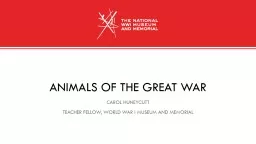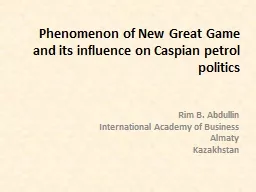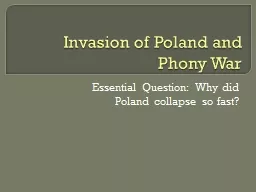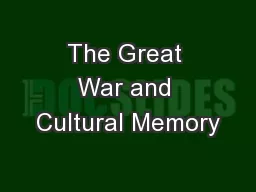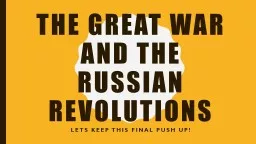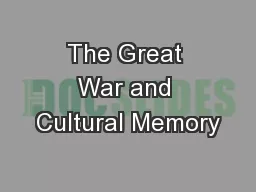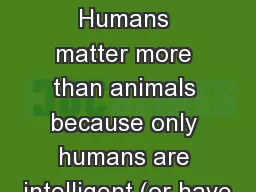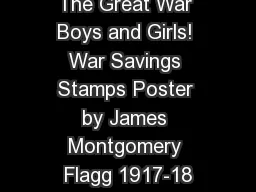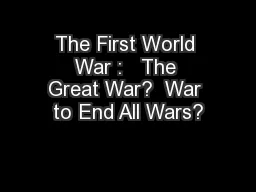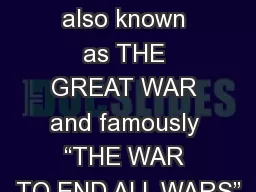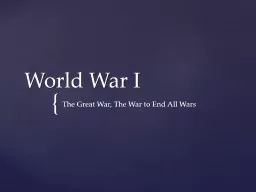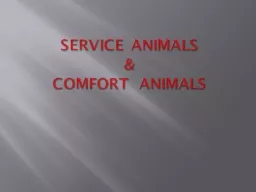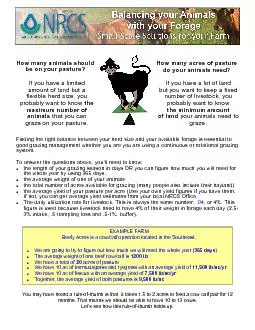PPT-Animals of the great war
Author : lois-ondreau | Published Date : 2018-10-10
Carol huneycutt Teacher fellow world war I museum and Memorial Horses During the course of the war approximately one million horses were used by soldiers on both
Presentation Embed Code
Download Presentation
Download Presentation The PPT/PDF document "Animals of the great war" is the property of its rightful owner. Permission is granted to download and print the materials on this website for personal, non-commercial use only, and to display it on your personal computer provided you do not modify the materials and that you retain all copyright notices contained in the materials. By downloading content from our website, you accept the terms of this agreement.
Animals of the great war: Transcript
Carol huneycutt Teacher fellow world war I museum and Memorial Horses During the course of the war approximately one million horses were used by soldiers on both sides of the conflict Horses were used to transport goods and troops. great-great-great-grandmother(level5ancestor) great-great-grandmother(level4ancestor) _ great-grandmother(level3ancestor) _ grandmother(level2ancestor) _ mother(level1ancestor) _ you _ andsoon(andsimi Rim B. Abdullin. International Academy of Business . Almaty. Kazakhstan. Structure. Introduction. Neo-Realism theory. Shanghai Cooperation Organization – China and . Russia: Union . for . cooperation. Essential Question: Why did Poland collapse so fast?. September 1, 1939. Hitler led a surprise attack at dawn on Poland. . Planes invaded Polish airspace, raining bombs and terror. . German tanks and 1.5 million troops invaded the Polish border. . Memory of WW1. The origin of ‘modern memory’ . Shell-shock, trauma: individual and collective . 9 million casualties . Britain: 750.000 + 230.000 (Spanish flu) . H.H. Asquith (PM); Kipling; A. A. Milne, Hugh . Lets keep this final push up!. The Great War:. Stalemate 1914-1917. Outdated battle strategy, especially, by the French made the war very bloody. Believed spirit would win the battle . Germany was on the brink of winning the war at the very start . Memory of WW1. The origin of ‘modern memory’ . Shell-shock, trauma: individual and collective . 9 million casualties . Britain: 750.000 230.000 (Spanish flu) . H.H. Asquith (PM); Kipling; A. A. Milne, Hugh . Second Reason. : Humans matter more than animals because only humans are self-aware (or have the potential for self-awareness).. The fact that the human being can have the representation “I” raises him infinitely above all the other beings on earth. By this he is a person....that is, a being altogether different in rank and dignity from things, such as irrational animals, with which one may deal and dispose at one's discretion.. I Can:. Identify & analyze the causes & significant events of World War I & their impact.. Evaluate the impact of the Treaty of Versailles.. 2. The First World War:. When?. . 3. War involving nearly all the nations of the world. Chapters 22-25 . History Alive!. , Ch. 11 . Americans. History Alive!. . Ch. . 22: From Neutrality to War . p. . 283-291. “Was it in the national interest of the US to stay neutral or declare war in 1917?”. It was a global military conflict that took place mainly in Europe between 1914 & 1918.. It was a . total war. which left great devastation, millions dead and shaped the modern world.. World War I created a decisive break with the old world order that had emerged after the Napoleonic Wars. The results of World War I would be important factors in the development of World War II; 21 years later. M – . Militarism. : Fascination with war and a strong military. A – . Alliances. : Agreements among varying nations to help each other out. I – . Imperialism. : Building empires and competition for markets. La gamme de thé MORPHEE vise toute générations recherchant le sommeil paisible tant désiré et non procuré par tout types de médicaments. Essentiellement composé de feuille de morphine, ce thé vous assurera d’un rétablissement digne d’un voyage sur . What is the difference between a . Service. and an Emotional Support Animal?. A . service animal. is any guide dog, signal dog, or horse individually trained to provide assistance to an individual with a . EXAMPLE FARM much we will need the whole year (11,500 lb/ac/yr7,500 lb/ac/yr held up pretty good, 11 cows on 20 acres, is 1.8 acres per cow. We have enou our cows for the whole yeargood estimate and
Download Document
Here is the link to download the presentation.
"Animals of the great war"The content belongs to its owner. You may download and print it for personal use, without modification, and keep all copyright notices. By downloading, you agree to these terms.
Related Documents

